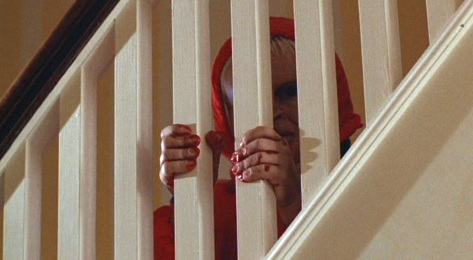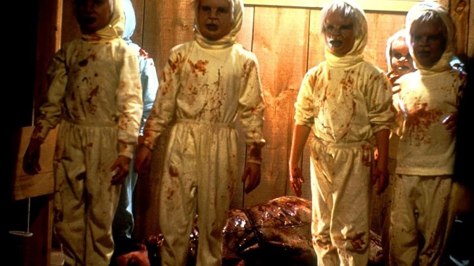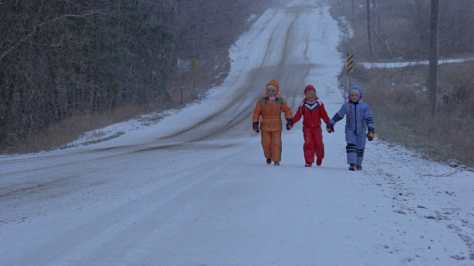
David Cronenberg’s name is synonymous with body horror—he spent the first three decades of his career defining it (and recently came back to it after a long absence), pushing the envelope when it came to fleshy protuberances and disturbing hybridization. But as repulsive as the effects could be in his movies, they’ve never really felt like puerile shock for its own sake, as there has always been a sense of fascination about the way bodies could be warped, and an equal amount of fascination with how physical changes affect people. They are visceral both physically and psychologically, and that’s why Cronenberg’s filmography is a thing unto itself, an idiosyncratic fusion of horror and science fiction.
It all started in low-budget exploitation films of the seventies, beginning with Rabid and Shivers, all shot in his home town of Toronto (where all, or at least most, of his movies have been filmed), which overcame moral outcry from local sources who took umbrage at their combination of sex and violence to be reasonably profitable, allowing him to continue making increasingly larger-scale movies. All of his obsessions were there from the beginning, from bizarre body modifications and infections to, yes, a combination of sex and violence (and music brought to us by regular collaborator and future Lord of the Rings composer Howard Shore)—and his seventies run culminated in The Brood, distributed by Roger Corman’s New World Pictures, which was the big leagues, comparatively speaking. Here, Cronenberg went beyond just the parasitic terror of his first two movies and turned to both parenthood and psychotherapy, and with those themes created some of those notably Cronenbergian images that would define his aesthetic. But this is a movie that is also deeply personal in a way that his other movies aren’t, which makes it all the more disturbing.

It shouldn’t come as a shock to anyone watching The Brood that the director had been going through an acrimonious divorce and child custody battle around the time this was written (Cronenberg provides the laugh line that it’s “like Kramer vs. Kramer, but more emotionally honest”)—everything here is meant to parallel what was going on in his life at the time. Frank Carveth (Art Hindle, also seen in the influential Canadian horror movie Black Christmas) wants to take away visitation rights from his mentally-ill wife Nola (Samantha Eggar, co-star of Doctor Dolittle) when he finds evidence of physical abuse on their five-year-old daughter Candice, but is told outright by his lawyer that “the courts favour the mother”—so, in order to protect his child, Frank begins gathering evidence that the Somafree Institute run by radical psychotherapist Dr. Hal Raglan (Oliver Reed, acting as the “well-known actor lending gravitas to a horror movie”) is crooked and worsening her condition. There is certainly a sense of one-sided anger in how this is presented, with Frank as the sane man having to go out of his way to prove that his wife is unfit as a parent—and certainly there have been analyses of this movie that paint this is a faintly misogynistic exercise, with symbols of womanhood used as a source of horror, let alone the fact that this is a male filmmaker using his art to paint a picture of his own conflict with his wife. As the movie moves along, though, it becomes much more complicated.

Primarily, there is the character of Dr. Raglan and his theory of “psychoplasmics” (there is nothing more Cronenberg than just that made-up word), as laid out in his book The Shape of Rage, where his intense talk therapy tries to expel deep-seated psychological damage through physical manifestations, usually taking the form of welts or rashes on the body. He is presented in a way that cuts between radical academic, self-help guru, and cult leader (as it turns out, Cronenberg’s ex-wife eventually joined a cult), and we see patients of his suffering long term conditions, with one dying from a bizarre lymphoma on his neck (the first truly Cronenberg-like make-up effect you see), and another shown to be entirely dependent on Raglan as a substitute father figure. While coming off as callous at times, Reed plays the role as someone with seemingly only a genuine desire to help people with his method,but even so, he is the consummate mad scientist, no different from any of the ones seen in classic horror movies—someone who has, through hubris, unleashed a force that he has himself cannot control. While Cronenberg is not the first filmmaker to make a mad scientist tied directly to a fantastical form of psychiatry, his conception of it is still truly unique in how the mental and the fleshy intertwine.

The thing Raglan unwittingly unleashed ties directly to parent-child relationships, and the way that abuse passed down from generation to generation. Nola was physically abused by her alcoholic mother, but also sees her own father’s lack of intervention as an equally great failing—when we meet both of them, the father seems genuinely remorseful, while the mother never acknowledges her part in her daughter’s mental deterioration or any of her other problems (which makes Frank’s willingness to leave Candice alone with her a little odd.) Part of Raglan’s therapy is taking on the role of those people and getting Nola to say what she really thought of them—and soon after those sessions, her parents end up dead, killed by a mysterious figure that breaks into their family home. Both of her parents clearly failed her, and Dr. Raglan as her current caregiver has also failed her by not changing course when the effects of his therapy become evident. While Nola is never portrayed as being entirely innocent, there is clearly some sympathy for her, or at least an understanding that people don’t get to be this way for no reason (and at one point Frank says that she had hoped that in their relationship, his sanity would “rub off on her.”) Frank’s real fear is that all this trauma will be passed down once again to Candice, whose tendency to respond to horror (including finding her grandmother’s dead body) by shutting down and not talking about it adds to the sense of tragedy—tying things back to the other theme of the movie, it is even suggested by a child psychologist that the stress of the situation could lead to her developing ulcers.

It’s interesting that the scenes of violence earlier in the movie seem so traditional compared to what we start seeing later on in it—they don’t seem so different from an early slasher movie. If we didn’t start hearing about “psychoplasmics” from the first moments, one could probably think that this is an early slasher movie, with these child-sized killers hiding in a house and murdering people with blunt force trauma (their preferred method.) It’s not like most horror movies of this stripe didn’t already use mental illness as a tasteless source of horror, either. Cronenberg has said that he considers this one of his more “classic” horror movies, and both the mad scientist angle and the straightforward thriller-style scenes certainly give it that feel.

There is also a mundane suburban quality to the movie, especially with the detailed interiors of the homes, a now-historical aesthetic that it shares with fellow parenthood horror classic It’s Alive. That in turn leads to just how Canadian it also feels—not only is this explicitly set in Toronto (unlike all the exploitation movies that were just clearly shot there), but the dim, snowy outdoors are a very specific visual tone that adds to the overall creepiness in the film. I do think it’s appropriate that such a Canadian movie would turn kids in snowsuits into an image of terror, although it may also be a visual nod to the child-in-a-raincoat imagery from the thriller Don’t Look Now.

All that relative normalcy changes once we get a real look at the diminutive stalker, and get a long exposition scene where a coroner lays out its strange biology—we are now in Cronenberg country. The titular brood, who all bear a disturbing resemblance to Candice but with distorted faces and ape-like screeches, are like fleshy homunculi, existing only to serve the unconscious whims of their mother with an intentionally limited lifespan. These things are quite literally the shape of her rage, the idea of parenthood twisted into creating monstrous extensions of yourself. Considering how the rest of the movie played out, this sudden intrusion of weird, clinically-explained science fiction may have come out of left field to the regular horror audience, who at the time would have no idea what a David Cronenberg movie entailed. That’s just the beginning, too: since the violence in this movie is not even particularly gruesome, (although the attack at the kindergarten is far more horrific if only for the context), the real horror imagery is saved for the climax, where Frank confronts Nola and she reveals the external womb she has developed thanks to psychoplasmics. The famous moment is, of course, when she tears the fleshy sac open with her teeth and licks the bloody newborn clean (an idea apparently contributed by Eggars), her new form of motherhood manifesting as entirely animal-like. Eggars’ wide-eyed mania in that scene, and even in the therapy scenes between her and Reed where she is allowed to act out her frustration and confusion, is probably just as distressing as all the little child monsters and mutant wombs, projecting the idea that she doesn’t really know what she’s doing, but embraces it anyway because she thinks it will lead to her regaining here loving family (which was why she appeared so happy that Candice and Frank were coming back to her.) Despite the movie setting up her own victimhood, though, she goes off the edge in the end (“I seem to be a special person”, she tells Frank), saying that she would kill Candice rather than let Frank take her away from her, which goes right back to the concerns from the beginning of the movie.

That climax is one of the defining images in Cronenberg’s oeuvre, and it may be a bit surprising how much of The Brood is more of a subtle build-up to the body horror, rather than a cavalcade of it that you see in Videodrome or The Fly. Those movies are maybe more dramatically and artistically complex, made without a need to even resemble the kind of grindhouse fare Cronenberg started out making, but there’s a distinct intensity in this, using the horror imagery and the ideas to grapple with one of the more distressing forms of interpersonal conflict. Monsters are at their most interesting when they are used to express some facet of the world, or more importantly in this case, some facet of yourself—and while some may be able to make some critical assessments of their artist’s state of mind at the time this was made, it has a palpable rawness, a sense that it too is a product of anger.

